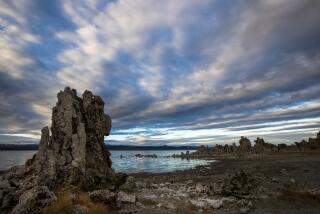A Major Drain for Unstable Reservoir
State engineers announced Monday that they planned to drain 42% of Lake Perris, a reservoir and popular recreation spot southeast of Riverside, because of seismic instability.
Studies show that a 7.5-magnitude earthquake in the nearby San Jacinto fault zone could damage the 31-year-old Perris Dam enough to flood Perris and Lake Elsinore, said Rich Sanchez, principal engineer with the state Department of Water Resources, which owns the dam.
Officials said there was no imminent danger, but that drawing the water down 25 feet was a first step toward repairing the dam. The lowering is “really in the interest of public safety,” said Sue Sims, public affairs director with the Department of Water Resources.
Officials said the risk was not known before the dam was built because seismic analysis was not as sophisticated as today’s.
Sims said the department hoped to minimize the effect on the 1.1 million annual visits by boaters, anglers and scuba divers. “It would be naive to say that there wouldn’t be any impact there,” Sims said.
At Lake Perris, the park’s superintendent, Ron Krueper, estimated that 30,000 people visit the lake on summer weekends. He said the state Department of Parks and Recreation would evaluate the potential effect of the drainage this week.
Rancho Cucamonga fisherman and business owner Ryan Yang was less reserved.
“It’s bad news,” he said. Yang owns the Fishing 25 bait and tackle store in Perris. “It’s bad for fishing, bad for water sports and everything,” he said, adding that his business might have to close.
“If the water level’s down, the fish have stress, so the fishing slows down,” Yang said. He said he might not be able to launch his boat when the lake is shallower.
Over two months, starting in mid-August, roughly 52,000 acre-feet of water will be gradually distributed for household and business use across Southern California. The lake is the southernmost reservoir of the State Water Project.
Computer modeling by state engineers and review by independent consultants last month showed weaknesses under the dam’s foundation that could cause it to slump during a major quake, Sanchez said. Such damage could trigger an uncontrolled release of water that could inundate downstream communities, Sims said. The reservoir’s maximum operating capacity is nearly 127,000 acre-feet.
An acre-foot is the amount of water that covers 1 acre to a depth of 1 foot, or about enough to supply the needs of two families for a year.
The water level will stay lower indefinitely as engineers determine how best to repair the dam, a process that could take years, Sanchez said. Possibilities include adding more sections to strengthen it or reinforcing the foundation soil. But the state has not yet launched a detailed study of how to repair the dam and what it would cost. “That’s sort of our next step,” Sanchez said.
Drawing off water will have no effect on water availability for Southern California consumers, said Bob Muir, spokesman for the Metropolitan Water District of Southern California. “Depending on how long we lose the storage provided in Perris, we can go to another source or to another facility; they can help pick up the slack,” Muir said.
The water district hasn’t encountered a drainage of this magnitude in at least a decade, he said.
This is the only dam of nearly two dozen owned by the Department of Water Resources to be drained because of seismic concerns; the department does not anticipate any more of its dams requiring such work, Sanchez said.
Calaveras Dam near San Francisco, Lopez Dam in San Luis Obispo County and San Pablo Dam in the East Bay, which are owned by local agencies, all have undergone similar drainage and repairs, Sanchez said.
More to Read
Sign up for Essential California
The most important California stories and recommendations in your inbox every morning.
You may occasionally receive promotional content from the Los Angeles Times.










